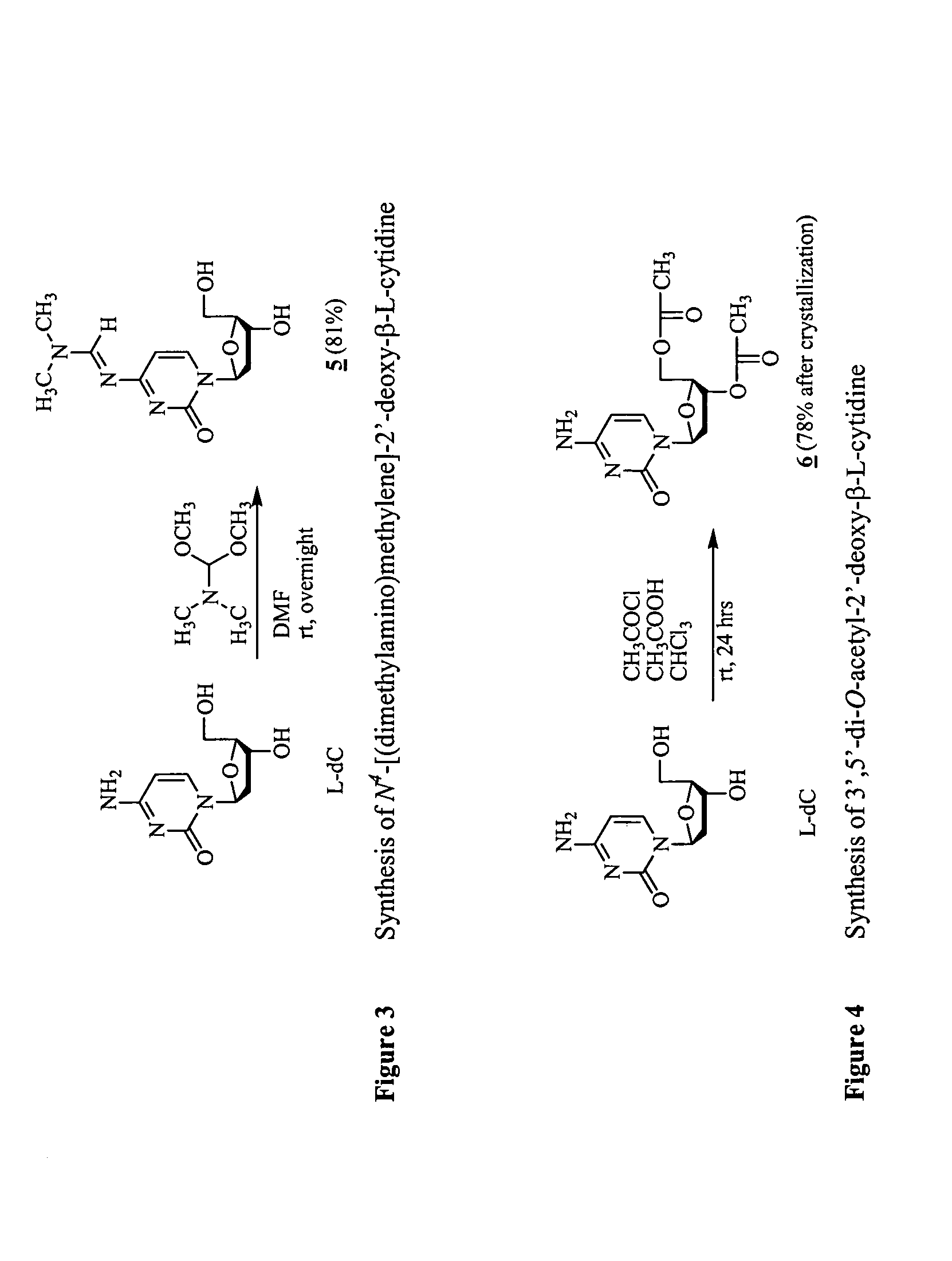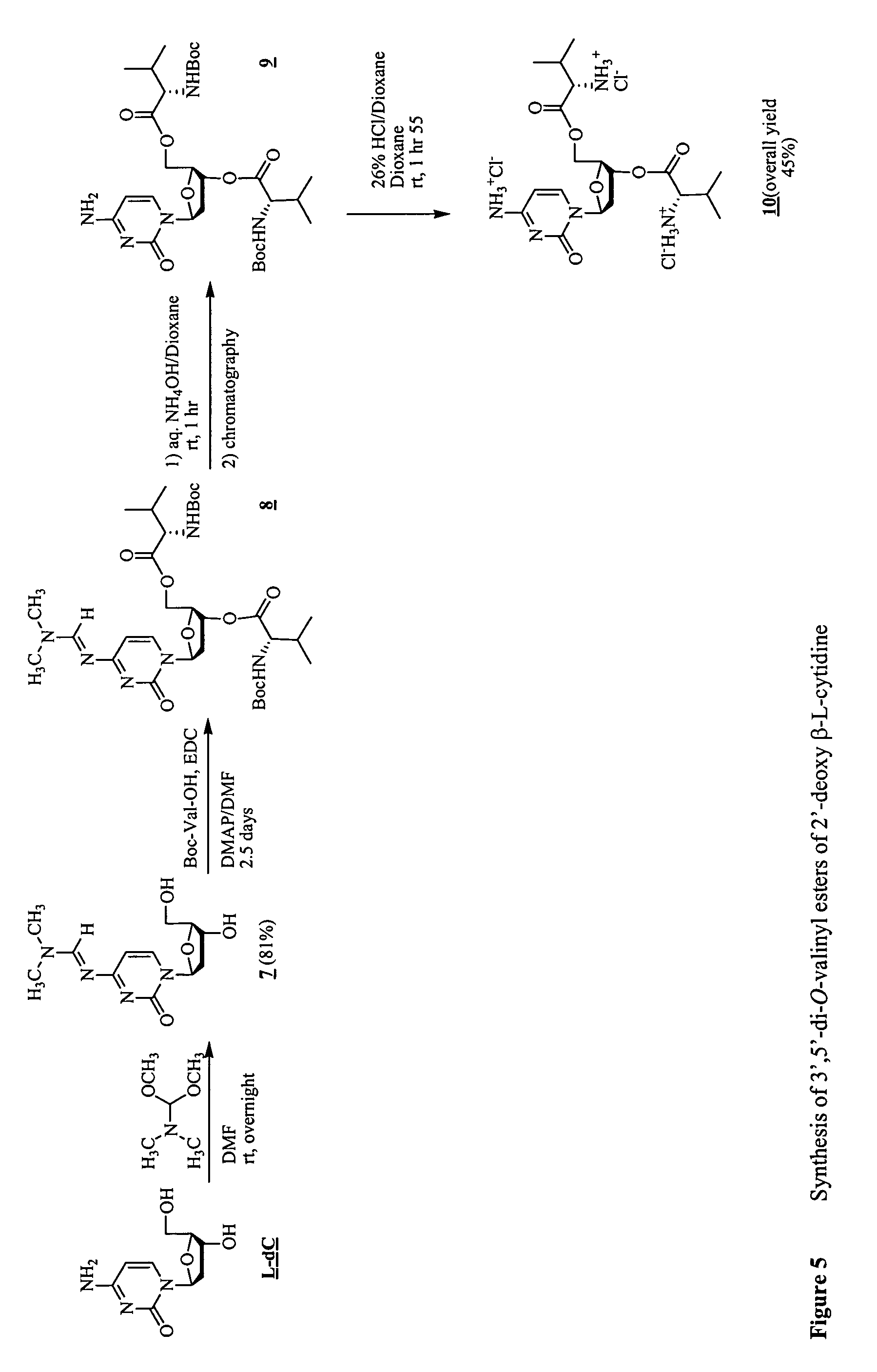β-L-2′-deoxynucleosides for the treatment of resistant HBV strains and combination therapies
a technology of hbv and deoxynucleosides, which is applied in the direction of biocide, drug composition, peptide/protein ingredients, etc., can solve the problems of fulminant hepatitis, rapid progression, and jaundice in the abdomen, and achieve the effect of suppressing the emergence of the hbv double mutan
- Summary
- Abstract
- Description
- Claims
- Application Information
AI Technical Summary
Benefits of technology
Problems solved by technology
Method used
Image
Examples
example 1
[0544]
1-(3,5-Di-O-benzoyl-β-L-xylofuranosyl)uracil (2)
[0545]Hydrazine hydrate (1.4 mL, 28.7 mmol) was added to a solution of 1-(2-O-acetyl-3,5-di-O-benzoyl-β-L-xylofuranosyl)uracil 1 [Ref.: Gosselin, G.; Bergogne, M.-C.; Imbach, J.-L., “Synthesis and Antiviral Evaluation of β-L-Xylofuranosyl Nucleosides of the Five Naturally Occurring Nucleic Acid Bases”, Journal of Heterocyclic Chemistry, October–November 1993, 30, 1229–1233] (4.79 g, 9.68 mmol) in pyridine (60 mL) and acetic acid (15 mL). The solution was stirred overnight at room temperature. Acetone was added (35 mL) and the mixture was stirred for 30 minutes. The reaction mixture was evaporated under reduced pressure. The resulting residue was purified by silica gel column chromatography [eluent: stepwise gradient of methanol (0–4%) in dichloromethane to give 2 (3.0 g, 68%) which was crystallized from cyclohexane / dichloromethane: mp=111–114° C.; 1H-NMR (DMSO-d6): δ 11.35 (br s, 1H, NH), 7.9–7.4 (m, 11H, 2 C6H5CO, H-6), 6.38 (d,...
example 2
[0549]
2-Amino-β-L-arabinofurano-[1′,2′:4,5]-oxazoline (5)
[0550]A mixture of L-arabinose (170 g, 1.13 mol: Fluka, >99.5%, ref 10839), cyanamide (100 g, 2.38 mol: Fluka, >98%, ref 28330), methanol (300 mL), and 6M-NH4OH (50 mL) was stirred at room temperature for 3 days and then kept at −10° C. overnight. The product was collected with suction, washed successively with methanol and ether, and dried in vacuo. Yield, 130 g (66.0%) of the analytically pure compound 5, m.p. 170–172° C.; 1H NMR (DMSO-d6) δ ppm 6.35 (br s, 2H, NH2), 5.15 (d, 1H, H-1, J=5.6 Hz), 5.45 (br s, 1H, OH-3), 4.70 (br s, 1H, OH-5), 4.55 (d, 1H, H-2, J=5.6 Hz), 4.00 (br s, 1H, H-3), 3.65 (m, 1H, H-4), 3.25 (m, 2H, H-5, H-5′).
O2,2′-anhydro-β-L-uridine (6)
[0551]A solution of compound 5 (98.8 g, 0.57 mol) and methyl propiolate (98 mL: Fluka, >97%, ref 81863) in 50% aqueous ethanol (740 mL) was refluxed for 5 hours, then cooled and concentrated under diminished pressure to the half of the original volume. After precipita...
example 3
[0557]
3′,5′-Di-O-benzoyl-2′-deoxy-5-iodo-β-L-uridine (11)
[0558]A mixture of compound 9 (105.8 g, 0.242 mol), iodine (76.8 g: Fluka, 99.8%, ref 57650), cerium ammonium nitrate (CAN) (66.4 g: Aldrich, >98.5%, ref 21,547-3) and acetonitrile (2550 ml) was stirred at 80° C. for 3 h then the reaction mixture was cooled at room temperature leading to crystallization of compound 11 (86.6 g, 63.5%); m.p. 192–194° C.; 1H NMR (DMSO) δ ppm .8.34 (s, 1H, NH), 8.2–7.2 (m, 11H, 2 C6H5CO, H-6), 6.31 (q, 1H, H-1′, J=5.5 Hz and J=8.7 Hz), 5.5 (m, 1H, H-3′), 4.7 (m, 2H, H-5′, H-5″), 4.5 (m, 1H, H-4′), 2.7 (m, 1H, H-2′), 2.3 (m, 1H, H-2″); FAB−, 237 (B)−; FAB>0 (GT) 563 (M+H)+; [α]D20+39.05 (c=1.05 in DMSO); UV (EtOH 95) υmax=281 nm (ε=9000), υmin=254 nm (ε=4000), υmax=229 nm (ε=31000); Anal. Calcd for C23H19IN2O7: C, 49.13H, 3.41N, 4.98I, 22.57. Found: C, 49.31H, 3.53N, 5.05I, 22.36.
3′,5′-Di-O-benzoyl-2′-deoxy-3-N-toluoyl-β-L-thymidine (13)
[0559]To a solution of compound 11 (86.6 g, 0.154 mol) in anhy...
PUM
| Property | Measurement | Unit |
|---|---|---|
| Volume | aaaaa | aaaaa |
| Volume | aaaaa | aaaaa |
| Volume | aaaaa | aaaaa |
Abstract
Description
Claims
Application Information
 Login to View More
Login to View More - R&D
- Intellectual Property
- Life Sciences
- Materials
- Tech Scout
- Unparalleled Data Quality
- Higher Quality Content
- 60% Fewer Hallucinations
Browse by: Latest US Patents, China's latest patents, Technical Efficacy Thesaurus, Application Domain, Technology Topic, Popular Technical Reports.
© 2025 PatSnap. All rights reserved.Legal|Privacy policy|Modern Slavery Act Transparency Statement|Sitemap|About US| Contact US: help@patsnap.com



